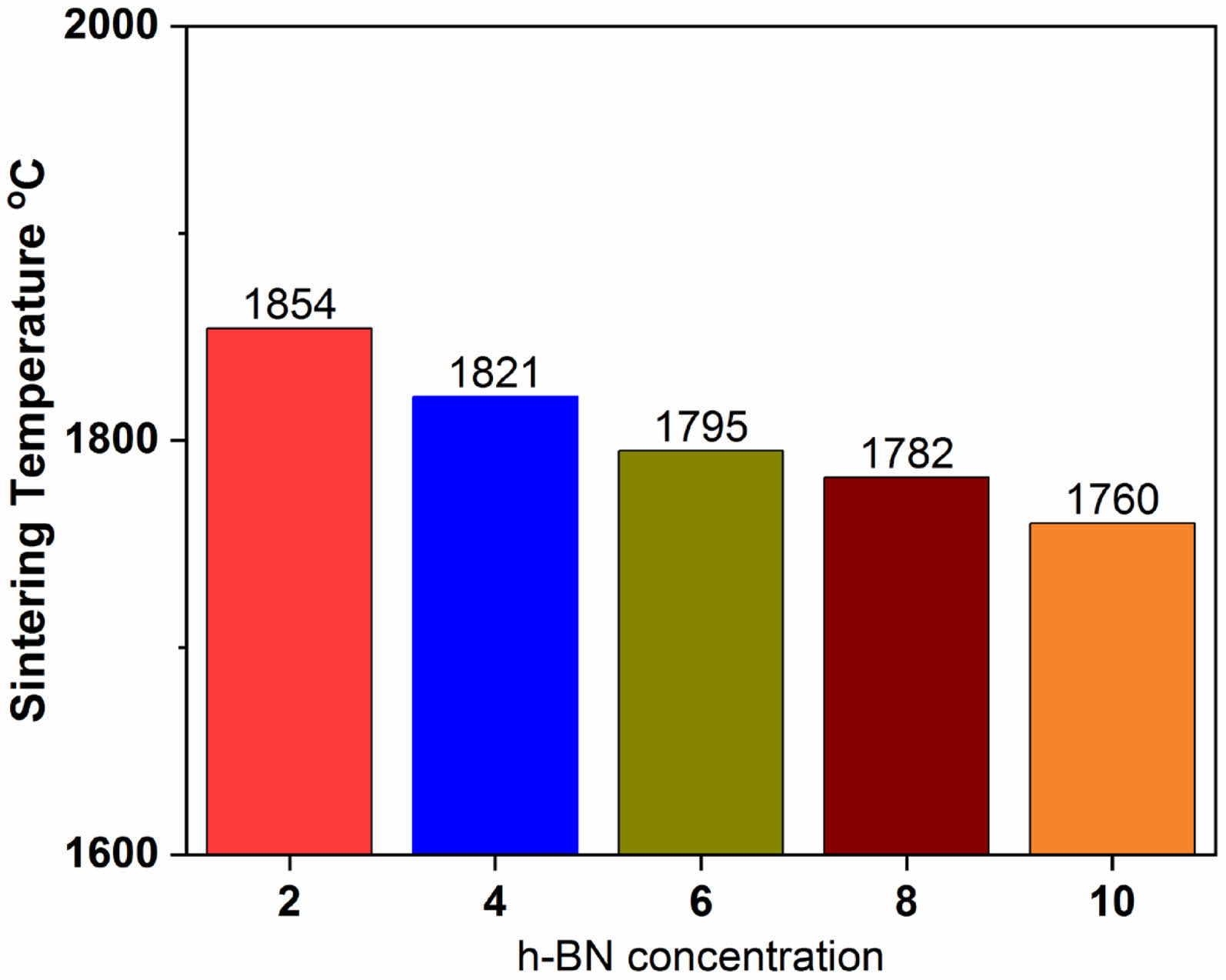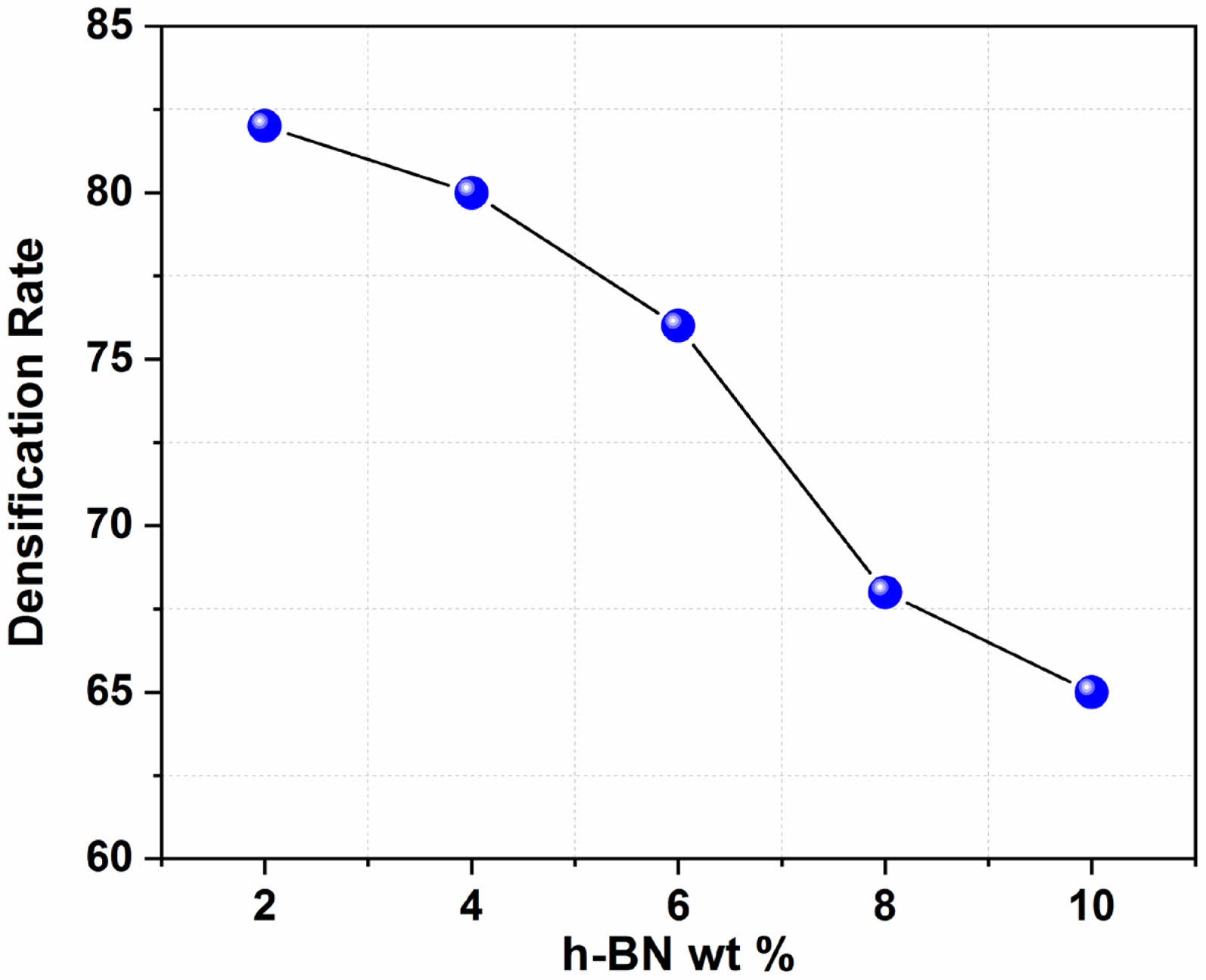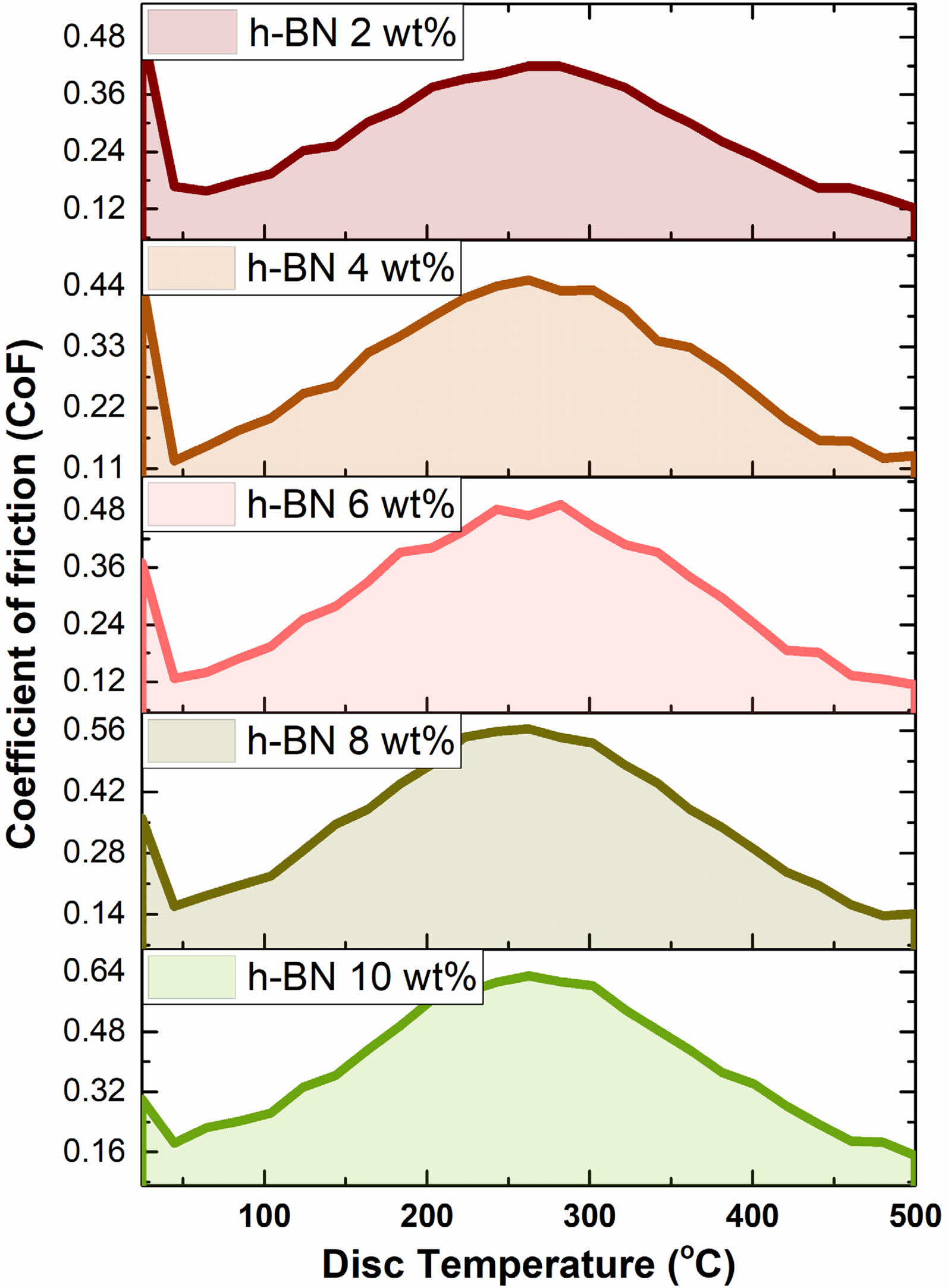- Investigating hexagonal boron nitride additives in ceramic based friction materials for track bicycle brake pads
Shuhua Tang*
Geely University of China, Chengdu, 641423 China
This article is an open access article distributed under the terms of the Creative Commons Attribution Non-Commercial License (http://creativecommons.org/licenses/by-nc/4.0) which permits unrestricted non-commercial use, distribution, and reproduction in any medium, provided the original work is properly cited.
This research investigates the synergistic effects of hexagonal boron nitride (h-BN) as sintering additives in aluminum nitride (AlN) ceramic processing. The study aims to assess the impact of incorporating h-BN on the sintering behavior and properties of AlN ceramics. h-BN, renowned for its thermal stability and lubricating properties, is explored as a strategic additive to enhance the densification process and overall performance of AlN-based materials. The research focuses on understanding the influence of varying concentrations of h-BN on sintering temperatures, densification kinetics, and mechanical properties of the AlN ceramics. Additionally, the investigation into the coefficient of friction (CoF) of samples with varying concentrations of h-BN revealed distinct trends as the disc surface temperature increased during continuous braking tests. This investigation provides valuable insights into the role of hexagonal boron nitride as a sintering aid tailored for AlN, contributing to the optimization of processing parameters and the advancement of high-performance ceramic materials.
Keywords: Friction materials, Aluminum nitride, Hexagonal boron nitride, Braking pads, Braking test.
Ceramic materials, with their applications spanning from electronics to aerospace, are now being increasingly utilized in the automotive sector, particularly in Track Bicycle brake pads. The unique demands of Track Bicycle brake pads necessitate advancements in processing techniques to optimize the frictional properties, wear resistance, and mechanical strength of these materials. Aluminum nitride (AlN) ceramics have garnered significant attention in this regard, especially concerning the sintering process, which plays a pivotal role in determining the final characteristics of the brake pads. The incorporation of sintering additives has emerged as a key strategy to tailor the properties of AlN ceramics, enhancing their performance for specific applications like Track Bicycle braking systems. These additives are carefully selected based on their ability to influence the kinetics of densification, sintering temperatures, and, consequently, the overall performance of AlN ceramics. Sintering, the additives at elevated temperatures, is critical for achieving the desired density, microstructure, and mechanical properties in the final ceramic product, which directly impacts the performance of brake pads.
To overcome challenges associated with traditional sintering methods, the introduction of additives has become a focal point of research. These additives are carefully selected based on their ability to influence the kinetics of densification, sintering temperatures, and, consequently, the overall performance of AlN ceramics in braking applications. This research delves into the broader landscape of sintering additives in AlN ceramic processing, seeking to understand their diverse roles and impact on the final material properties crucial for Track Bicycle brake pads. In the context of Track Bicycle brake pads, the utilization of additives becomes especially crucial as these components demand ceramics with enhanced thermal conductivity, mechanical strength, and tailored functionalities [1]. The hot pressing method, for instance, not only serves to reduce sintering time but has also proven effective in enhancing sintering densification. For example, Jin et al. prepared capsule-like h-BN-coated AlN powders through a nitridation reaction in nitrogen gas, subsequently sintering them using the hot-pressing technique with varying BN content [2]. Their findings indicated that the flexural strength of the resulting composite ceramics exhibited a gradual decline with an increase in BN content, a factor critical to the performance of brake pads.
Makarenko et al. employed low-temperature aluminum diboride (AlB2) as a precursor to generate composite AlN-BN-based powders [3]. The compact samples derived from these synthesized powders demonstrated a bending strength ranging from 235 to 240 MPa when subjected to hot pressing, relevant for ensuring the mechanical robustness of brake pads. Similarly, He et al. produced AlN-BN composites using Sm2O3-CaF2 as sintering additives through spark plasma sintering, revealing the highest thermal conductivity value reaching 85 Wm-1 K-1 with the introduction of 8 wt% sintering aids [4].
In this context, the exploration of various sintering additives becomes paramount, focusing on their synergistic effects during the sintering process specifically for brake pads. The aim is not only to achieve densification but also to fine-tune the microstructure and mechanical attributes of AlN ceramics to meet the stringent demands of Track Bicycle braking systems. Among the various potential additives, hexagonal boron nitride (h-BN) stands out as a candidate of interest due to its unique thermal stability and lubricating properties [5-9]. These properties make h-BN a compelling candidate to enhance the densification process during sintering, with potential benefits for the microstructural and mechanical properties of the resulting AlN ceramics, crucial for brake pad applications.
This study seeks to assess how the strategic incorporation of h-BN can influence the sintering behavior and overall performance of AlN-based materials in the context of Track Bicycle brake pads. The investigation aims to unravel the intricacies of this synergistic relationship by varying concentrations of h-BN during the sintering process. The outcomes of this study are anticipated to contribute significantly to the optimization of processing parameters and the advancement of high-performance ceramic materials specifically tailored for Track Bicycle brake pads. As industries continue to demand materials with enhanced properties, the exploration of innovative additives such as h-BN holds promise for shaping the landscape of ceramic processing and application in Track Bicycle braking systems.
High-purity raw powders were meticulously prepared as the foundation for the ceramic processing. Scaled quantities of raw powders were subjected to a thorough ball milling process for 12 hours. This milling operation employed high-purity zirconia milling balls as grinding media. The ball milling was conducted in an anhydrous ethanol medium, ensuring an optimal environment for powder refinement. Slurry Formation and Drying: Following the ball milling, the resulting powder mixtures were transformed into slurries through a carefully controlled process. The slurries were maintained at 65℃ in a rotary vacuum evaporator, facilitating the removal of the ethanol medium and promoting homogeneity within the powder mixture. Subsequently, the dried powder mixture underwent an additional drying phase for 24 hours at 80℃ in a drying oven. To further enhance powder homogeneity and reduce agglomeration, the dried powders were screened through a 200-mesh sieve. Sintering Process: The prepared and refined powder mixtures were subjected to a controlled sintering process to achieve the desired ceramic characteristics. The sintering process was executed in a state-of-the-art hot press furnace with a heating rate of 20℃/min. The sintering temperature was set at 1900℃, and the duration was precisely maintained for 1 hour. This thermal treatment was carried out under a pressure of 50 MPa in a nitrogen atmosphere, ensuring optimal conditions for the consolidation and densification of the ceramic materials.
The incorporation of h-BN as a sintering additive introduces a dynamic element to the thermal processing of AlN ceramics, particularly in the context of Track Bicycle brake pads. Varying concentrations of h-BN in the sintering process play a crucial role in influencing the achieved sintering temperatures, thereby impacting the overall densification and material properties essential for effective brake pad performance. As observed in Fig. 1, there is an inverse relationship between h-BN concentration and sintering temperature. As the concentration of h-BN increases, the required sintering temperature decreases. This phenomenon aligns with the lubricating properties of h-BN, which facilitate enhanced particle rearrangement and densification at lower temperatures [10, 11]. The data suggests the potential for optimizing sintering temperatures based on the desired characteristics of the final AlN ceramics, which directly impacts the performance of Track Bicycle brake pads. Lowering sintering temperatures not only conserves energy but also may have implications for reducing thermal stresses and enhancing the overall efficiency of the manufacturing process. In the context of brake pads, this optimization can lead to components that are more durable and perform reliably under various cycling conditions.
It is noteworthy that, beyond a certain concentration (e.g., 10%), the reduction in sintering temperature tends to stabilize. This indicates a potential saturation point where the benefits of h-BN concentration on lowering sintering temperature plateau. This stabilization can be particularly beneficial for the production of brake pads, as it provides a predictable and controlled manufacturing environment, ensuring consistent quality and performance.
While the focus here is on sintering temperatures, the observed trends in the data should be correlated with microstructural analyses to understand the impact on the final properties of AlN ceramics, specifically for Track Bicycle brake pads. The influence of varying h-BN concentrations on grain size, porosity, and phase composition should be explored to comprehensively assess material characteristics. For brake pads, these microstructural properties are crucial as they affect the wear resistance, thermal stability, and overall frictional performance.
The addition of h-BN as a sintering additive introduces a dynamic element to the densification kinetics during the processing of AlN ceramics. Varying concentrations of h-BN significantly influence the rate and extent of densification, shaping the microstructure and, consequently, the final properties of the ceramics. Moreover, as the concentration of h-BN increases, there is a consistent trend of decreasing densification rates. This can be attributed to the lubricating properties of h-BN, which promote enhanced particle rearrangement but may reduce the overall driving force for densification. Optimal Concentration for The data suggests that at
lower concentrations (e.g., 1-3%), the densification rate is relatively high, indicating efficient particle packing. This range may be considered optimal for achieving substantial densification while maintaining favorable processing kinetics [12, 13]. Trade-off between Lubrication and Densification. Higher concentrations of h-BN (e.g., 7-10%) exhibit reduced densification rates (Fig. 2).
This emphasizes a trade-off between the lubricating effect of h-BN, which aids in particle movement, and the necessity for strong particle bonding during densification (Fig. 2). The challenge lies in balancing these contrasting effects to achieve the desired material properties. The observed trends in densification kinetics should be correlated with microstructural analyses to understand the implications for grain growth, porosity, and overall structural integrity. A balance must be struck to achieve optimal densification without compromising the mechanical properties of the final ceramic. It is crucial to consider the interplay between h-BN concentrations, sintering temperatures, and densification kinetics. The correlation between these factors can provide insights into the overall thermal processing strategy for AlN ceramics.
Effect of the h-BN concentrations on coefficient of friction (CoF)
The investigation into the CoF of samples with varying concentrations of hexagonal h-BN revealed distinct trends as the disc surface temperature increased during continuous braking tests. Across all tested samples, it was observed that higher concentrations of h-BN correlated with increased CoF values, suggesting that the incorporation of h-BN significantly influences the frictional behavior of the material. The graph (Fig. 3) depicting the variation of CoF with disc surface temperature shows a profile reminiscent of a stretched mountain, indicating that CoF values initially rise with temperature, reach a peak, and then decline. This characteristic pattern suggests that as the temperature increases, the frictional properties of the composite material are enhanced up to a certain point, beyond which the effectiveness diminishes.
For lower h-BN concentrations, the CoF values remained relatively moderate throughout the temperature range, indicating stable frictional performance but not reaching the higher CoF values observed in samples with greater h-BN content. This stability at lower temperatures can be advantageous for applications requiring consistent performance without the need for high frictional forces. In contrast, samples with higher h-BN concentrations demonstrated a more pronounced increase in CoF, peaking at higher temperatures. This peak suggests an optimal temperature range where the material's frictional properties are maximized, potentially due to the better thermal stability and lubricating properties of h-BN. However, beyond this optimal range, a decline in CoF was observed, possibly due to the thermal degradation of the composite structure or changes in the surface characteristics of the material.
The results indicate that by adjusting the h-BN concentration, it is possible to tailor the frictional properties of the composite material for specific temperature ranges and applications. Higher h-BN concentrations are beneficial for applications requiring higher CoF at elevated temperatures, while lower concentrations offer more consistent performance across a broader temperature range.

|
Fig. 1 Effect of h-BN concentration on the Sintering temperature |

|
Fig. 2 Effect of h-BN concentration on the Densification Rate. |

|
Fig. 3 Variation of the CoF with disc surface temperature during continuous braking tests for samples containing different concentrations of h-BN. |
In conclusion, the manipulation of h-BN concentrations during the sintering process offers a versatile tool for tailoring sintering temperatures and, consequently, the processing parameters of AlN ceramics, specifically enhancing the performance of Track Bicycle brake pads. This understanding provides a foundation for optimizing the synthesis of high-performance ceramics with properties that meet the stringent demands of brake pad applications. The reduction in sintering temperature with increased h-BN concentrations not only conserves energy but also enhances the efficiency of the manufacturing process, leading to more durable and reliable brake pads. Further investigations into the nuanced effects of varying h-BN concentrations on microstructure and material properties will contribute to the broader understanding of advanced ceramic processing. The influence of varying concentrations of h-BN on densification kinetics underscores the intricate relationship between lubrication and densification, which is critical for achieving the desired frictional performance and wear resistance in Track Bicycle brake pads. The findings offer valuable insights into optimizing the synthesis of AlN ceramics by strategically manipulating h-BN concentrations, paving the way for enhanced control over material properties and processing efficiency. Continued research into the microstructural consequences of these kinetics will contribute to a comprehensive understanding of advanced ceramic processing, ultimately leading to the development of superior Track Bicycle brake pads that offer improved safety, performance, and durability for cyclists.
- 1. W.S. Cho, M.W. Cho, J.H. Lee, and Z.A. Munir, Mater. Sci. Eng: A 418[1] (2006) 61-67.
-

- 2. H.Y. Jin, W. Wang, J.Q. Gao, G.J. Qiao, and Z.H. Jin, Mater. Lett. 60[2] (2006) 190-193.
-

- 3. G.N. Makarenko, L.A. Krushinskaya, V.B. Fedorus, T.V. Dubovik, A.V. Kotko, M.G. Andreeva, and I.V. Uvarova, Powder Metall. Met. Ceram. 49 (2011) 670-674.
-

- 4. X. He, Q. Gong, Y. Guo, and J. Liu, J. Alloys Compd. 675[5] (2016) 168-173.
-

- 5. S.H. Lee, H. Tanaka, and T. Aoyagi, J. Eur. Ceram. Soc. 29[10] (2009) 2021-2027.
-

- 6. M. Kakiage, Y. Tominaga, I. Yanase, and H. Kobayashi, Powder Technol. 221[257-263] (2012) 257-263.
-

- 7. L. Harynski, A. Olejnik, K. Grochowska, and K. Siuzdak, Opt. Mater. 127 (2022) 112205.
-

- 8. K.H. Kim, K.B. Shim, J.H. Chae, J.S. Park, and J.P. Ahn, J. Ceram. Process. Res. 10[6] (2009) 716-720.
-

- 9. Rafi-ud-dina, G.H. Zahida, Z. Asghar, Muhammad Maqbool, E. Ahmada, T. Azhar, T. Subhani, and M. Shahzada, J. Asian Ceram. Soc. 2[3] (2014) 268-274.
-

- 10. M. Alrwashdeh and S.A. Alameri, Energies 15[21] (2022) 8008.
-

- 11. Z. Yang, Y. Qi, and J. Zhang, Construct. Build. Mater. 223 (2019) 928-938.
-

- 12. M. Alrwashdeh, S.A. Alameri, and A.K. Alkaabi, Nucl. Sci. Eng. 194[2] (2020) 163-167.
-

- 13. Y.J. Joo, J.W. Kim, K.B. Shim, and C.J. Kim J. Ceram. Process. Res. 19[4] (2018) 342-346.
-

 This Article
This Article
-
2024; 25(4): 690-693
Published on Aug 31, 2024
- 10.36410/jcpr.2024.25.4.690
- Received on Jun 13, 2024
- Revised on Aug 12, 2024
- Accepted on Aug 13, 2024
 Services
Services
Shared
 Correspondence to
Correspondence to
- Shuhua Tang
-
Geely University of China, Chengdu, 641423 China
Tel : +86-13778821515 Fax: +86-028-63286199 - E-mail: 13778821515@163.com






 Copyright 2019 International Orgranization for Ceramic Processing. All rights reserved.
Copyright 2019 International Orgranization for Ceramic Processing. All rights reserved.